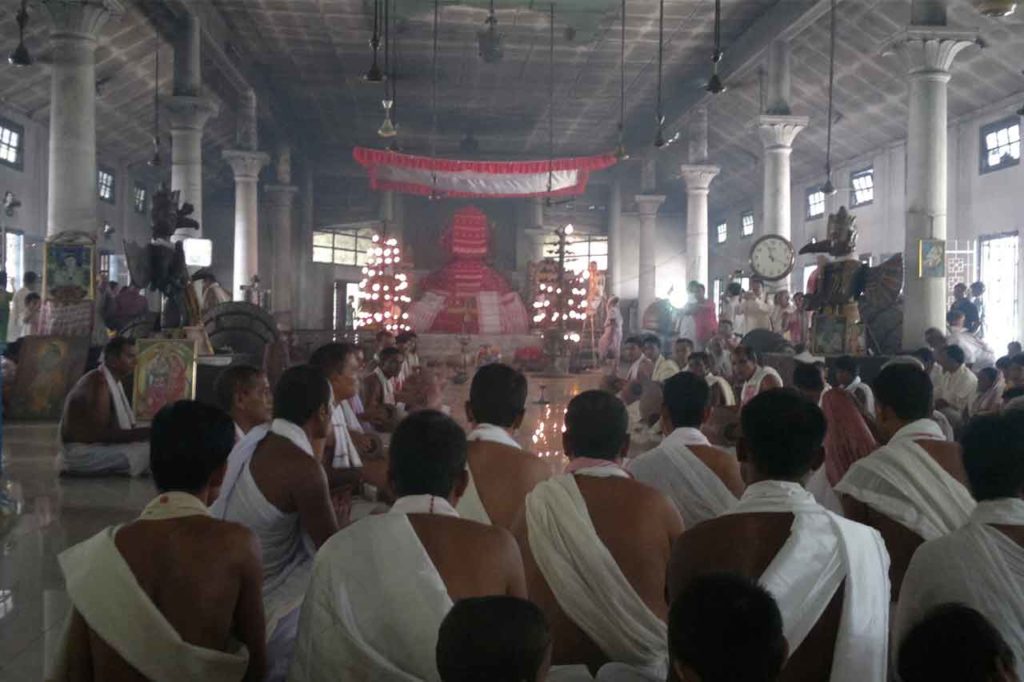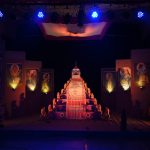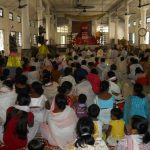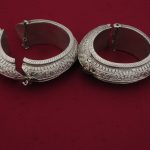Srimanta Sankaradeva was a stalwart who strode over the cultural scenario of Assam for more than a century during his life-time in the medieval period. But more importantly, he continues to influence the cultural world even four and a half centuries after his demise. Madhavadeva, Ram Rai, Narayanadas Thakur, Damodaradeva, Ananta Kandali, Ram Saraswati, Kanthabhushana, and Harideva were among the prominent disciples of Srimanta Sankaradeva. The age-old Than, Satra, and organizations like Srimanta Sankaradeva Sangha, Asom Satra Mahasabha, Mahapurushiya Satra Samaj, Krishnaguru Sewashram, Ekasarana Bhagavati Samaj etc have carried forward the religious and cultural traditions initiated by the saint.
The Sankari culture, which is also known as Sattriya culture in an extended form, has been accepted as the main-stream culture of the state. It is the unifying bond of the numerous ethnic groups living in the Brahmaputra valley. The Assamese nation came into being mostly at the initiative of Srimanta Sankaradeva. None of the kings and emperors, who ruled in this valley before and after the saint’s lifetime could achieve that. The reason is that the concept of nation-state is not tenable in Assam, which is full of numerous ethnic groups. So no single king could ever build a nation within the confine of his ethnic domain.
There is a common misconception among a section of people that the founder of Ahom dynasty, Swargadeo Chukapha (1228-1268 AD) was the father of Assamese nation. But the fact is that Swargadeo Chukapha created only a kingdom, not a nation. He would have been a nation builder, had the Assamese nation been like the unitary European nations. But Assamese nation is a multi-ethnic conglomerate. The concept of nation state as in Europe does not apply here. Numerous nation states existed in the Brahmaputra valley in medieval period. There were kingdoms of the Ahoms, the Kochs, the Chutiyas, the Kacharis, the Bhuyans and so on. Each of these was a nation state. Swargadeo Chukapha was the founder of the nation state lived in by the Ahoms and two other tribes, the Barahis and the Morans, who had submitted to the prowess of the Ahoms. Chukapha did not rule over the composite Assamese race. The composite Assamese race had not come into existence till then.
Srimanta Sankaradeva was the man who brought the composite Assamese nation into being with his cultural revolution in the fifteenth century. There was no Assamese nation in the thirteenth century for Swargadeo Chukapha to rule over. Nevertheless Chukapha’s contribution is important in the annals of Assam history. That he integrated at least three tribes was a significant step. The modern Assamese nation therefore remember him gratefully. But in the ultimate analysis, he was an empire-builder, not a nation-builder. Moreover his kingdom covered only a fraction of the area lived in by the composite Assamese nation. So we should better not compare these two great personalities. They were playing supplementary roles. Area-wise, the Barman king, Bhaskar Barman (594-650 AD) had ruled over the entire area now inhabited by the modern Assamese nation for the first time as per historical records. In fact his area included parts of Bihar, Orissa also. Thereafter the Koch king, Maharaj Nara Narayana (1540-1587 AD) ruled over the entire area now inhabited by the modern Assamese nation, but for a brief period of only one year 1562-1563 AD. However these expansionism do not make one the father of a nation.
Srimanta Sankaradeva created the composite Assamese culture with ingredients from all ethnic groups from within the geographical boundary of Brahmaputra valley. His most important innovatory contribution, the Kirtan-ghar or Namghar was derived from the Mising Murang-ghar. The Kirtan-ghar is as multi-faceted as the Murang-ghar. Of course there were several changes made into it. While the Murang-ghar was constructed on a wooden platform, the Kirtan-ghar was constructed on ground. Moreover the military aspect was deleted from Murang-ghar while making the Kirtan-ghar. Even the size of these two houses are similar. The Mising people have contributed many other things to the Sankari culture. The Hai-re hand-posture of the Sankari or Sattriya dance was derived from the Mising dance.
The Tai-Ahoms contributed many important elements to the composite Assamese culture created by Srimanta Sankaradeva. The main pillar of the Kirtan-ghar is known as Laai-khoota. This is a Tai-Ahom word. It means the main pillar. The hymns sung as prayer in the Naam-Prasanga sessions in the Ek Sarana Nama Dharma preached by Srimanta Sankaradeva has many tunes taken from the Tai-Ahom tradition. The practice of saying glory to God as well as giving blessing to the devotees by uttering Zoi at the end of such prayer sessions is also derived from the Tai-Ahoms. The sculpture of the flying lion affixed in the altar, Guru-asana of the Kirtan-ghar was derived from the Mangolean sculpture of dragon. The followers of Ek Sarana Nama Dharma continued with this practice of picking good things from the ethnic groups. The practice of writing hagiographies of Srimanta Sankaradeva and his prominent disciples was probably derived from the Ahom habit of writing history. Even the word Than, used for denoting the residential campus in the Ek Sarana Nama Dharma is found in the Ahom history Satsari Asom Buranji. (3rd edition, 1969 AD, p. 5) Srimanta Sankaradeva used many ethnic words in his own writings also.
The dresses of the Sankari danceuse and the actors of his Ankiya plays were derived to a great extent from the Tiwa dresses. The tune of their Lali-hilali songs were incorporated in Naam-Prasanga as well as the classical Bargeet composed by Srimanta Sankaradeva and Madhavadeva. These Bargeet songs are one of the main modes of conveying the principles of the Ek Sarana Nama Dharma. The popular instrument (drum) Nagara, which is used in community prayer sessions, is also a contribution of the Tiwa people. Another instrument of the Tiwas, the Ludang khram is very much akin to Khol. It may be mentioned that though Khol was innovated to some extent from the ancient Mridanga, the accoustic property of Khol differ a lot from Mridanga. It is pertinent here that the Kachari tribe also has an ancient tradition of playing Dhol or drum.
The Ghuri worn by the Sutradhar, the compere of the Ankiya plays was taken from the white Jhama of the Rabhas. The jacket worn by him was derived from the Khangaliphaga of the Tiwas. The half-moon shaped entry of the danceuse in the Sankari or Sattriya dance is a trait probably taken from them. The Bodos, the Dimasas and the Misings also have this trait. The Gayan-Bayan tradition has been derived from the Sonowal Kachari tribe. The headgear of the Sutradhar is similar to that of the Jaintia tribe. It was worn by other tribes also, because such a headgear is seen in a thirteenth century sculpture of Mahisha demon found in Tinisukia. This headgear travelled to outside the Brahmaputra valley. The Mughal emperors adopted it, whence it came back again to the valley with a new name, Moghlai topi. But it is actually a purely indigenous heritage.
The Bodo tribe contributed some postures to the Sankari or Satriya dance from their Bagrumba. The combinations of left hand and right foot, and right hand and left foot is one such trait. Some other hand and feet postures of Bagrumba are also similar to the Sankari or Sattriya dance. Srimanta Sankaradeva used the stringed instrument Sarengda of the Bodo tribe. It was appropriate for singing Bargeet. It may be mentioned that the insruments used in the rest of the country are conspicuously absent in Bargeet or other Sankari songs.
Bihu dance, a common harvest dance of the Assamese people have influenced the Sutradhar dance as well as the battle dances of the Sankari or Sattriya dance. Such ancient heritages influencing this classical dance form are Oja-pali, Devadasi dance, Putala-nach etc. The dress of the Oja or leader in the Oja-pali dance is similar with that of Sutradhar to a great extent. The Putala-nach also contributed some characteristics to Sutradhar. The very word Sutradhar means the holder of strings i.e. the string-controller of the Putala-nach. The Karbi folk dance has also contributed own elements to it. The mask used by the actors in the Ankiya plays were taken from pure indigenous source. The Khamtis, the Bhutiyas and many other tribes have been using masks. The Bhor-tal was taken from the Bhutiyas. That was why it was earlier known as Bhot-tal. The Daba, a type of big drum kept in the Kirtan-ghar and the Sarai, a flat-top stand to keep the offerings to God, were also taken from indigenous ethnic sources.
Srimanta Sankaradeva had ready images and ingredients for use as materials in his performing arts, whether it be dance or music. The sculptures of Da-Parbatiya, Sri Surya hill, Ambari, Madana-Kamadeva devalaya, Na-Nath temple etc prove that abundantly. Sculptures of danceuses and dancing deities have been found at most of these places. This proves a long heritage of Assam in classical art. The Sanskrit treatise Abhinaya darpana says that the classical Lasya dance was created in ancient Assam by princess Usha, the daughter of king Bana of Sonitpur, and that this form spread in rest of India by the effort of princess Usha. The image of Nataraja was also created in Assam. It was therefore natural for the ethnic groups of the Brahmaputra valley to be rich in different performing arts. Srimanta Sankaradeva used some of these ethnic ingredients in constructing his art form. The use of indigenous clothes, utensils, architectures, flora and fauna in the manuscript paintings also prove this appreciation for indigenous traditions. The Sankari school of painting is a definite proof of recognition to ethnic cultures in the Ek Sarana Nama Dharma. Chitra-Bhagavata of Bali-Satra, Nagaon and other illustrated manuscripts prove this.
Srimanta Sankaradeva had genuine feelings for the ethnic groups. It is not that he only mouthed lip sympathy for these people. He wrote mostly in vernacular language, unlike others who wrote only in Sanskrit language. He used ethnic words in his writings. The person, who accompanied Srimanta Sankaradeva constantly was a Mising man, named Paramananda. His original name was Pangkong and he hailed from Ratanpur village of Majuli. Paramananda accompanied Srimanta Sankaradeva even to such places where the latter did not take any other soul. Srimanta Sankaradeva lived alongwith the Chutiyas, the Bodos, the Kochs, the Kaibartas, the Kumars, the Rajakas, the Jaintias, the Garos, the Muslims, etc at different times and in different places. Many such people stayed within the Than (Sattra) campus.
Srimanta Sankaradeva attended the second wedding of his younger brother Banganya, which was boycotted by others in the family because the latter was marrying a Kaibarta damsel. Radhika alias Yogamaya, another Kaibarta lady was engaged by the saint in the construction work of dam on Temporani rivulet. Not only that, Srimanta Sankaradeva allowed Yogamaya and her family to reside next to his own premise. Thus the erstwhile social hierarchy gave in after the advent of Srimanta Sankaradeva.
Srimanta Sankaradeva lived among the masses, not away from them. He had once ruled over a big kingdom stretching over the entire middle Assam of present days. There are records in the hagiographies that as many as ten thousand persons gathered in important occasions of this Bhuyan kingdom. But Srimanta Sankaradeva renounced this Bhuyan kingdom in order to avoid conflict with the Kacharis. There took place a serious conflict between the Bhuyans and the Kacharis in 1516 AD. The bloody conflict threatened to snowball. Then the saint advised his fellow people to give up the fertile land of Tembuwani in favour of the Kacharis. It was then that the Bhuyans migrated to North bank of Brahmaputra. Srimanta Sankaradeva lived thereafter as a common man.
Srimanta Sankaradeva did not accept royal officialdom offered by the Ahom king, Swargadeo Chuhungmung since there was a danger that it might create a hiatus between him and the masses. He was also careful in selecting his disciples. He did not accept such persons who would not abide by the egalitarian principle of his Eka Sarana Nama Dharma. That was why the Koch king, Maharaj Nara Narayana was refused Sarana (initiation). But the Koch prince, Generalssimo Chilarai was allowed to be a disciple because he was humble. The prince wept by rolling over the ground when Srimanta Sankaradeva passed away at Kochbehar in 1568 AD. Such devotion was the hall-mark of all Eka Sarana devotees. No doubt, the Eka Sarana Nama Dharma became a tool for social integration in the Brahmaputra valley. This process became more pronounced in the sub-cult named Kal-Sanghati. Even today the ethnic groups of Assam boast of the fusion process of Ek Sarana Nama Dharma that Sanskritized them without their giving up ethnic heritages.




